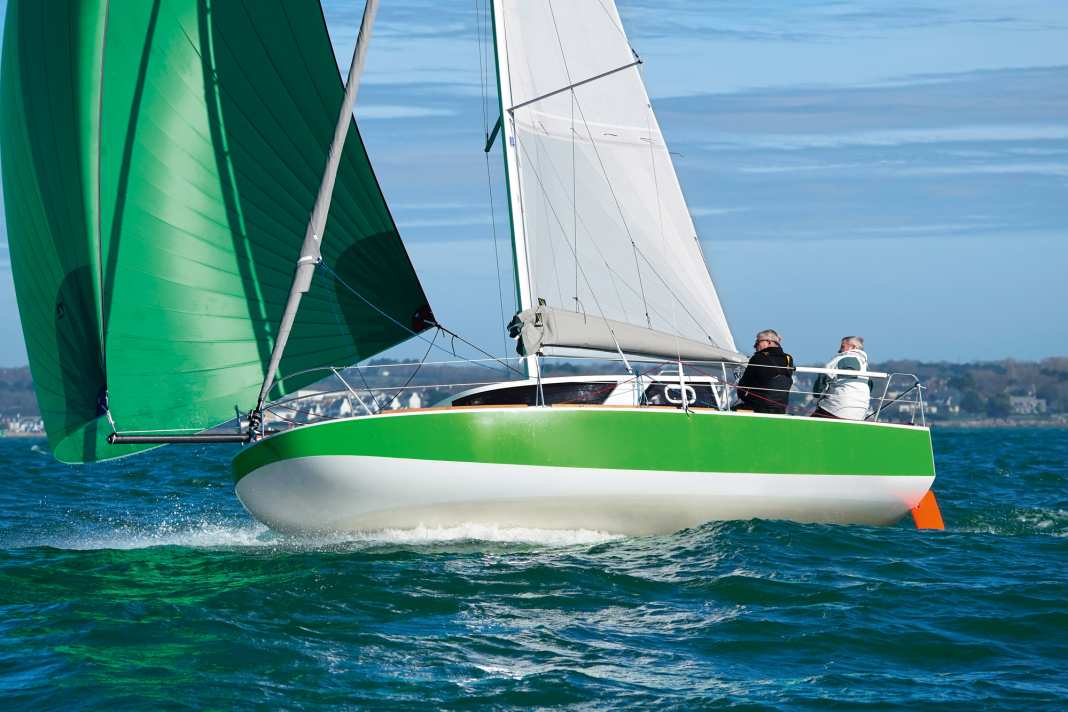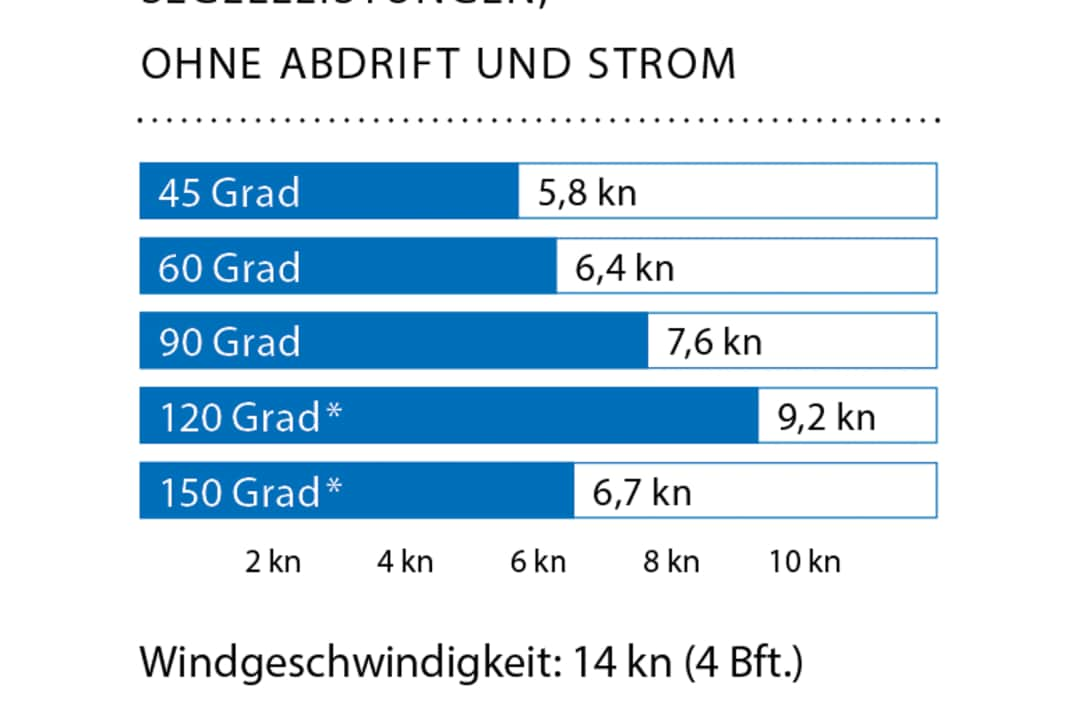





The forward, pointed end of a ship - this is how the bow is commonly described. As a rule, this banal and concise description gets to the heart of the matter. However, no rule is without exception, as is the case in yacht building - it is well known that there are ships without a bow in the usual sense, they are called scows. These are neither novel nor particularly exciting, but simply rare in this country. The most visually striking feature of scows is the wide, extremely flattened bow section without a sharply cut stem.
Over ten years ago, Frenchman David Raison introduced the idea of scows to the innovative Mini 6.50 class and won the demanding single-handed classic, the Mini Transat, with his legendary "Magnum" in 2011. Since then, the only 6.50 metre long and 3.00 metre wide sea dwarfs have generally developed strongly in the direction of scows. What's more, the minis with the flat nose are now regarded as the measure of all things in terms of competitiveness and chances of victory, both for prototypes and production boats.
The Maxi 650 series minis from the IDB Marine shipyard in Brittany are currently particularly successful and therefore also in demand. However, the boats in the Mini 6.50 class also appear to be of interest to sailors who just want to have fun with them and do not necessarily have a big offshore career in mind. IDB boss Pascal Benois reports surprisingly frequent requests for a touring and family-friendly counterpart to the pure racing flounder, which is delivered without any interior fittings.
The Mojito 650 is shorter, but wider
The shipyard has now responded to this by designing a new deck with a higher cabin superstructure and a continuous all-round window front for the fast hull of the Maxi 650. The fixed ballast is replaced by a hydraulically retractable swivelling keel and the boat is fully equipped for touring below deck. The result is the Mojito 650, probably the world's smallest real deck saloon yacht with seating and berths for up to four adults. And all this in a hull that is only slightly longer than that of a Flying Dutchman (FD) regatta dinghy, for example.
However, the minis are also excessively wide in relation to the hull length, namely an impressive 3.00 metres, including the Mojito 650, which corresponds to an aspect ratio of just 2.16. Normal boats, on the other hand, are usually around three times as long as they are wide, with an average aspect ratio of 3.0.
The disadvantages are obvious: limited space in harbours and restricted transportability by road, and only with special permission. After all, the Mojito 650 with its raised canting keel, two short stub rudders and a reduced draught of just 80 centimetres could also be launched and retrieved via a suitable slipway. And because the mast is positioned on the cabin superstructure, it would also be easy to raise by hand with optional hinges at the base of the mast.
No fewer than 47 strokes on the simple pump hydraulics are required to fully raise the swivelling keel. This is relatively strenuous and takes time. An electrically operated hydraulic system with push-button operation is available as an option, e.g. for frequent lowering and raising, for sailing in shallow water areas or for regularly falling dry in tidal waters.
For this purpose, the shipyard can equip the boat with telescopically extendable wading supports on request. The aluminium legs can be pushed out through tubes integrated into the hull on both sides and locked in this position. The boat can then easily remain standing on them and on the raised keel, even for longer periods. The shipyard holds a patent on this smart, innovative idea. Unfortunately, the supports were not yet installed on our test boat, the prototype.
Tourer with turbo
4 Beaufort, a short and steep wave and clear sunshine: the conditions for the test off Concarneau in Brittany are perfect. Assuming that it would get really wet on the small flounder in these conditions, the oilskin trousers seemed to be the right choice. But no! Hard on the wind, the little boat with its flat nose crashes quite violently into the waves, but it remains surprisingly dry in the back of the cockpit. Not even a small splash makes it to the helmsman, who sits directly on the side of the running deck.
It is well known that the courses against the wind are not exactly the Scows' favourite discipline. Even on the Mojito 650, the performance values upwind initially remain modest. Nevertheless, the little boat manages 5.8 knots on a course of 45 degrees to the true wind. The boat develops significantly more temperament as soon as you can steer it deeper with the sheets shrouded. With its excessive width, the radically stepped chine edges and the flat underwater hull, the Mini has enormous dimensional stability. The pressure from the rig is immediately converted into speed, not heeling.
The ride becomes even sportier with an additional coloured cloth. The gennaker is around 50 square metres in size and is set on a 1.40 metre extendable bowsprit and pulled right up to the masthead - plenty of motorisation. And bang, the log is over 9 knots at full planing speed; occasionally, with wave support, it even shows double-digit values.
Steering is demanding with the Mojito
The Seezwerg can be steered directly and extremely lively under pressure, just like a planing dinghy. The helmsman is surprised by an almost frightening dynamism. Because the bow does not go through the waves, but rather the boat as a whole goes over them, the flounder shows little course stability and literally bobs back and forth between the waves, like a cork on the surface of the water. This is very demanding and requires a lot of concentration at the tiller if you want to steer the boat quickly and optimally. After a short period of familiarisation, however, you will get used to the special movements and the fun factor increases exponentially.
The sail plan has a sporty design and provides for a squarehead mainsail with a wide top and a short overlapping genoa. The sail load factor (ratio of sail area to displacement) is a well above average (dimensionless) value of 5.8, although the Mojito 650 is not exactly a proven lightweight compared to the competition with a total weight of 1.2 tonnes ready to sail.
The dimensions of the aluminium mast with two pairs of strongly swept spreaders are identical to the rig used on the Maxi 650. The only difference is that the profile on the Mojito 650 touring boat is slightly thicker and the rig is stiffer overall, which means that the boat can manage without the double aft stays. Although this makes handling easier during manoeuvres, it also comes with deficits when trimming the rig - it is simply a compromise. Unfortunately, the sag of the genoa in the forestay cannot be adjusted at all or only to a limited extent via the mainsheet, especially when sailing close to the wind. However, aft stays can of course be retrofitted if the customer so wishes.
The upper and lower shrouds are separate on deck, allowing unhindered access from the cockpit to the foredeck. Additional safety and a good grip on the foredeck are provided by wooden rails as foot rails and an extremely non-slip deck structure, on which every shoe holds, but unfortunately also every pair of trousers breaks.
Eco-construction with flax
The Mojito 650 is built at IDB Marine in Tregunc, from A to Z; only a few add-on parts are bought in. In addition, the shipyard is now committed to an ecologically sustainable production method. In future, the boats will be built using natural flax fibres instead of glass fibres. Mats made from recycled PET material will be used as the core material for the sandwich constructions of the hull and deck. The structures are then built using a vacuum infusion process with polyester.
The double berth forward and the two single berths aft offer comfortable sleeping space for four adults. Children can also sleep on the benches. Even a large family could go on a cruise with the pocket-sized cruiser. Of course, there is no space for a wet room, but a portable chemical toilet can be stowed in a specially designated storage space under the companionway. And a small galley module with gas cooker can be integrated within the saloon table if desired - a smart solution.
There is plenty of storage space inside, under the bunk boards, but also in open shelves at the sides. However, there are no built-in lockers or cupboards. All kinds of equipment and additional sails are stored in the large storage space below the cockpit floor, which is easily accessible through a large hatch in the cockpit. However, there are no simple room dividers to prevent the stowage items from tumbling around wildly when heeling or in the waves.
Incidentally, the Mini is motorised with an outboard motor (electric or petrol), which is mounted on an attachable bracket at the rear.
Expensive speciality
Small flaws and some unsightly details in the interior fittings are obvious and are part of the prototype, which the shipyard only uses for testing purposes and does not sell. Shipyard boss Pascal Benois assures that all defects have been recognised and eliminated on build number 2 as the first series boat. Otherwise, the quality gives little cause for criticism. The basic equipment is first-class, and many technical add-on parts appear larger and more robust than they should perhaps be for such a small boat, for example the steering mechanism.
With a base price of 92,225 euros, the Mojito 650 is quite expensive compared to the competition. This does not even include the sails; by the time the boat is ready to sail, the many extra items add up, which is a lot for a yacht of this size. IDB Marine's exclusive pricing policy dampens the enthusiasm for a boat that is otherwise almost flawless and bursting with individuality and innovation. What a pity.
Not pretty, but fast
Boats with scow bows have many advantages, but also disadvantages



Frenchman David Raison is one of the celebrated stars of the 6.50 mini scene and the designer of many successful boats with scow bows, including the Maxi 650 from IDB Marine and its offshoot, the Mojito 650.
Raison explains the advantages of the unconventional hull shape as follows: Scows generate fewer waves and therefore release less energy into the water. The additional volume at the bow also provides a lot of dimensional stability in both the longitudinal and transverse axis. With the stiffer planing position, the pressure from the rig can be converted more efficiently into speed - the potential is effectively higher on all courses to the wind. Scows not only sail more upright than boats with conventional hull shapes, but also tend to dive over the bow much less, especially on room sheet courses with a lot of wind and sail area. The balance is therefore also more even in this direction of travel. And last but not least, the hull shapes offer more volume for the extension below deck, as with the Mojito 650.
However, David Raison is also aware of the disadvantages of scows, primarily the significantly larger wetted surface compared to conventional designs. More hull surface area in the water means more resistance and therefore more braking effect. And more volume ultimately also means more weight in the construction. With the same design, conventional hulls can be made lighter than those of the Scows - a not insignificant handicap, especially for real racers in the Mini 6.50 class.
The measured values for testing the Mojito 650




The Mojito 650 in detail

Technical data of the Mojito 650
- Design engineer:David Raison
- CE design category: C
- Torso length:6,50 m
- Width:3,00 m
- Draught (swivelling keel):0,80-1,85 m
- Weight:1,2 t
- Ballast/proportion:420 kg/35 %
- Mainsail:21,0 m²
- Furling genoa (105 %):17,0 m²
- Machine:Outboard motor
Hull and deck construction
Sandwich construction with flax fibre and PET recycling panels. Built using the vacuum infusion process with polyester
Price and shipyard
- Base price ex shipyard: 92,225 euros gross, incl. 19 % VAT.
- Warranty/against osmosis: 2/2 years
As of 9/2023, how the prices shown are defined can be found here !
Shipyard and distribution
IDB Marine, 29910 Tregunc (France); +33/608 93 01 14; www.idbmarine.com
YACHT rating
The good sailing characteristics of an offshore mini and the comfort of a small cruiser suitable for touring: the Mojito 650 manages the combination with a harmonious and well-rounded overall package. Unfortunately expensive
Design and concept
- + Bold, very independent concept
- + Ecologically sustainable construction
- - Comparatively high price
Sailing performance and trim
- + Lots of dynamics, especially on the beam
- + Noticeably high dimensional stability
Living and finishing quality
- + Enormous amount of space below deck
- + All-round visibility when seated
- - Processing defects in the prototype
Equipment and technology
- + Hydraulic swivelling keel
- + Robust mechanics
- - Limited trimming options
This article first appeared in YACHT 10/2021 and has been updated for this online version.

